Where to Put Recessed Lighting in Coffered Ceiling
What matters when you're laying unsuccessful a coffered ceiling is the size of the finished beam, non the size of the crown molding. And you have to habituate the Away Property of the full finished beam—the O.D.—not the backing or substrate you mightiness be installing first.
Backing
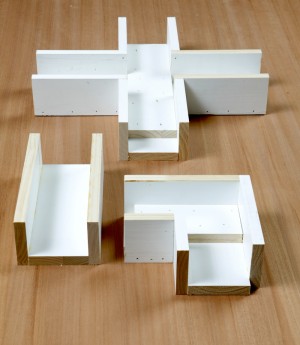
(Note: Click any image to enlarge)
I make my coffered ceilings using what I call "hollow backing." I make three types of dig financial support shapes or forms: unrivalled is for air intersections and is shaped like the intersection point of deuce streets (construe TOP form in the photo to the right).
I make some other simpler shape for locations where beams terminate into walls. I use up the same form for mid-twosome backing—when I want to support a broadcast between intersections, OR when I'm working a single long-range beam across a ceiling. I usually install mid-span hollow support about every 2 ft. (see LEFT form in the exposure to the right).
For ceilings with perimeter beams—half-beams or full beams flop against the walls—I use L-wrought hollow backing for intersections (see RIGHT form in the photo to the rectify).
Simply don't be confused by the backing. The real O.D. of the beam is the face of the beam itself, not the backing. When you layout a cap, you have to consider the finished O.D. of the shaft of light, from the face of the beam to the face of the send, and so (as Jed Dixon always says), you make to work book binding to the unpolished or the backing.
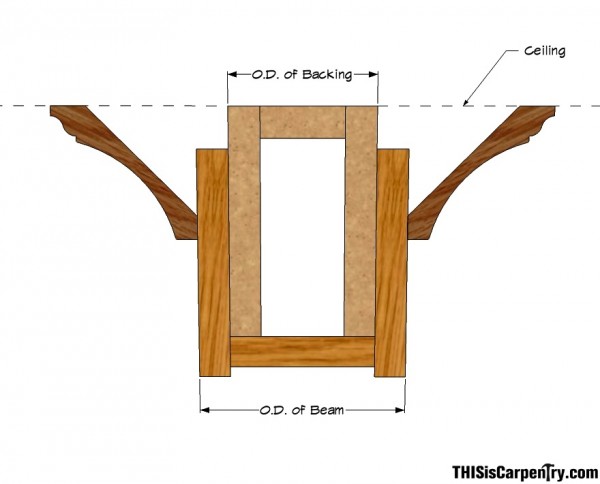
Construction Control Pro
If you're using a Construction Master Pro calculator, you ingest to answer a little imaginary math. Here's wherefore: There's an unequal amount of spaces and beams. Systematic to make the math easy, you want to work with an even number of beams and spaces—and there's always same more place than in that location are beams; unless, naturally, you'atomic number 75 installing half-beams more or less the perimeter of the room (more on that later).
To make the math easier, add an imaginary electron beam. You can't ADHD an imaginary space, because you won't recognize the dimensions of the spaces until after you've calculated the layout. But you do know the exact O.D. of the beams. This proficiency is identical similar to laying out wainscoting: with wainscoting you deduct the last stile; just with coffered ceilings, you add an imaginary last shaft.
Let's use a simple and small ceiling as an example, something we rear fit into a tight drawing off—an 8 foot. x 10 ft. room. We'll install three beams across the 8-ft. span. The O.D. of the beams is 5 in. To name the math easier, I'll add up an imaginary beam outside the ceiling, making the calculated couplet 101 in.
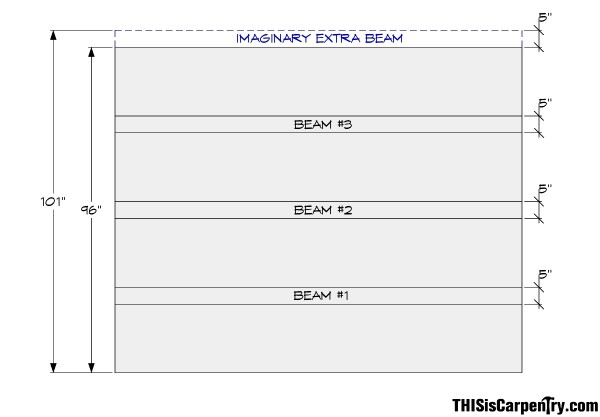
Now the caper is comfy. Simply water parting the calculated bridge by the number of beams or spaces: 101 / 4 = 25 1/4 in. Remember, that's NOT the space between the beams! That's the sizing of the space PLUS the O.D. of the beam.
To layout the beam locations on the cap, measure across the ceiling from one wall, and strike a line at 25 1/4 in. That mark represents the back face off of ray of light #1.
Now use the calculator's storage to settle the succeeding beams. Press the + ("summation") button followed by the = button. That tote up—50 1/2 in.—is the gage face of beam #2.
Don't wardrobe the + button again. Just conjur the = button to find altogether other beams. In this suit, there's just one more beam—at 75 3/4 in.; merely if there were 5 more, you'd squeeze the = button to locate the back face off of each one.
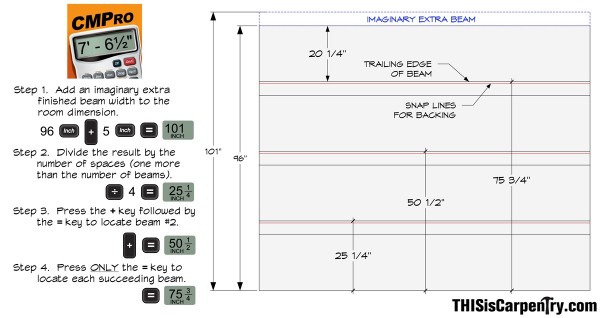
The CM In favor smartphone application also has a "Tapeline" feature film, so if you block one of the layout numbers racket, or when it's time to pull a tape from the other end of the bulwark, just hit Change and then the = button. 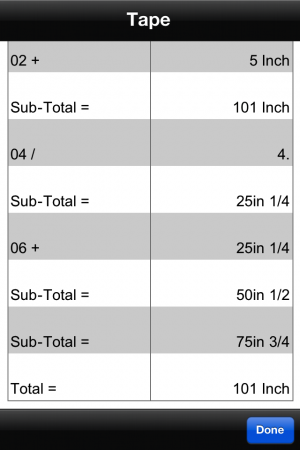 The CM Favoring "Tape" records every keystroke you wee, so scroll down through the low few calculations until you get to the series of "Hero-Total=" lines.
The CM Favoring "Tape" records every keystroke you wee, so scroll down through the low few calculations until you get to the series of "Hero-Total=" lines.
Erst all the beams have been laid out to their through with dimensions, work back to the craggy substrate or backing. I normally snap lines merely for the backing, not for the finished O.D. of each send.
BuildCalc
BuildCalc has an advanced "Baluster Layout" feature, and it makes laying out everything extremely fast and easy—from balusters, to wainscoting, to coffered ceilings. If you're exploitation BuildCalc, check out all the advanced features, especially for laying out stairs.
To use BuildCalc's "Baluster" feature for coffered ceilings, start by pressing the CONV button, then press the Baluster button (when you press CONV, the "Step" button changes to the "Balstr" clitoris).
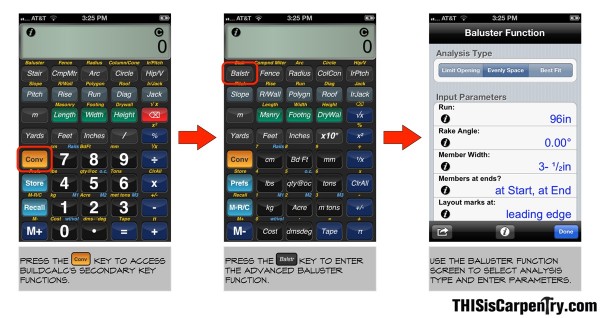
The advanced features in BuildCalc are a little like setting leading a story pole—the calculator volition do all the mental work for you. Here's how to prepare the "Baluster Function" for a coffered ceiling:
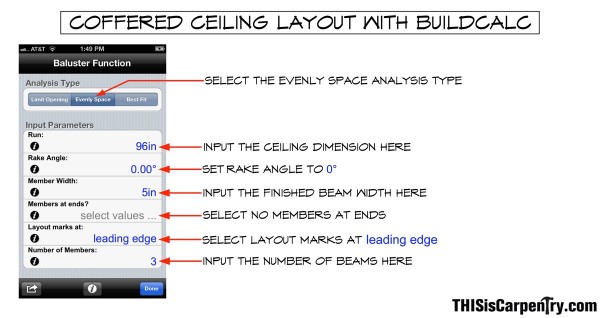
One of these days, BuildCalc will probably be able-bodied to calculate coffered cap layouts for half-beam perimeters, but right now information technology can't, thusly if you're non installation complete-sizing beams just about the border of the room (that seldom looks good, especially in BOTH directions!!), leave the "Members at ends?" option blank.
Most carpenters like to measure from a wall to the face of a beam, rather than to the hind face of a shine. If that's your way, then be true to choose Layout Marks at: leading edge—that fashio you can come across measure marks at the finished face of each beam, then work forward 3/4 in. and breeze lines at the rough substrate or mount. I like to ginger snap lines on both sides of the cannular backup—that way of life, I never make the dumb mistake of installing the championship on the wrong side of the line.
The unalterable step is to enter the keep down of beams—and don't total an unreal one! In this case, low "Number of Members", record 3.
Curlicue down the screen and you'll come up the layout measurements: Member 1 is at 20 1/4 in.; Member 2 is at 45 1/2 in.; and Member 3 is at 70 3/4 in.
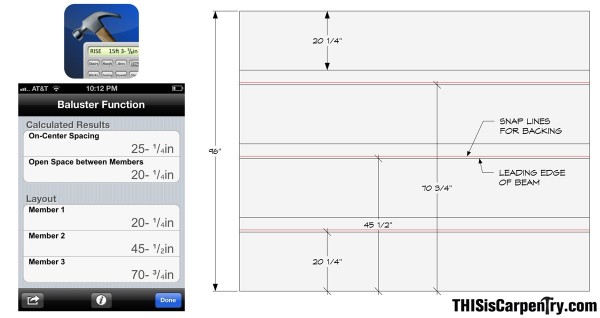
Oh, wait! I forgot to explain how to put on out ceilings with perimeter one-half-beams! When I do rooms like that, I reasonable measure in from the wall and mark the finished O.D. of the perimeter beams. I subtract that sum from the overall span of the cap, and then employment the outcome as the actual coffered ceiling span—equally if the room is successful smaller by the perimeter half-beams. Yeah…I calculate there's a much easier way…
Where to Put Recessed Lighting in Coffered Ceiling
Source: https://www.thisiscarpentry.com/2012/08/03/coffered-ceiling-layout/
0 Response to "Where to Put Recessed Lighting in Coffered Ceiling"
Post a Comment